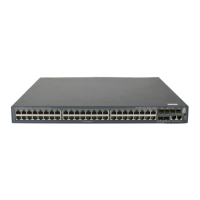92
Follow these steps to set the maximum number of authentication request attempts:
To do… Use the command… Remarks
Enter system view system-view —
Set the maximum number of
attempts for sending an
authentication request
dot1x retry max-retry-value
Optional
2 by default.
Setting the 802.1X authentication timeout timers
The network device uses the following 802.1X authentication timeout timers:
• Client timeout timer—Starts when the access device sends an EAP-Request/MD5 Challenge packet
to a client. If no response is received when this timer expires, the access device retransmits the
request to the client.
• Server timeout timer—Starts when the access device sends a RADIUS Access-Request packet to the
authentication server. If no response is received when this timer expires, the access device
retransmits the request to the server.
You can set the client timeout timer to a high value in a low-performance network, and adjust the server
timeout timer to adapt to the performance of different authentication servers. In most cases, the default
settings are sufficient.
Follow these steps to set the 802.1X authentication timeout timers:
To do… Use the command… Remarks
Enter system view system-view —
Set the client timeout timer
dot1x timer supp-timeout
supp-timeout-value
Optional
The default is 30 seconds.
Set the server timeout timer
dot1x timer server-timeout
server-timeout-value
Optional
The default is 100 seconds.
Configuring the online user handshake function
About the online user handshake function
The online user handshake function checks the connectivity status of online 802.1X users. The network
access device sends handshake messages to online users at the interval specified by the dot1x timer
handshake-period command. If no response is received from an online user after the maximum number
of handshake attempts (set by the dot1x retry command) has been made, the network access device sets
the user in the offline state.
If iNode clients are deployed, you can also enable the online handshake security function to check for
802.1X users that use illegal client software to bypass security inspection such as proxy detection and
dual network interface cards (NICs) detection. This function checks the authentication information in
client handshake messages. If a user fails the authentication, the network access device logs the user off.

